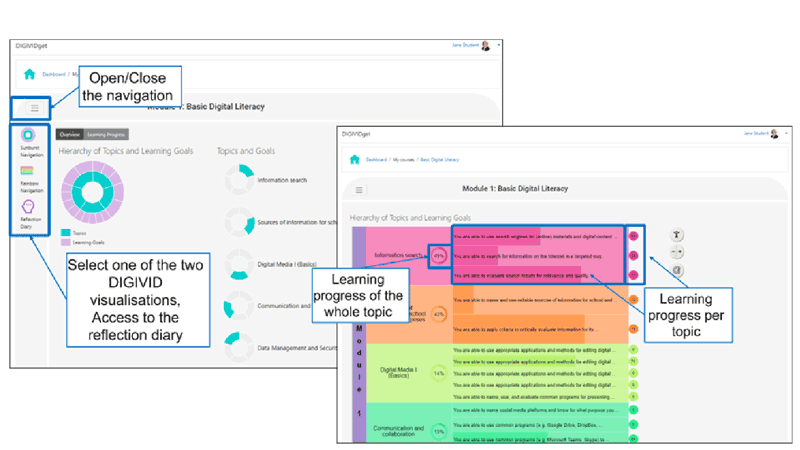by Angela Fessl and Katharina Maitz (TU Graz), Monica Divitini (NTNU)
Digital technologies have a great potential in supporting teaching practices. However, as also experienced during the COVID-19 pandemic, many teachers lack both the training and support they need to effectively use technologies in class or lecture halls. The DIGIVID project addresses this challenge with a system providing a comprehensive curriculum accessible through an innovative learning tool.
As are many other professionals, teachers are expected to use digital technologies in an effective way to improve and innovate their practices. In this context, one of the crucial challenges that teachers face is the acquisition of digital competences. Teachers must succeed as lifelong learners, both individually and collectively, to be able to adopt digital technologies and media to manage their teaching and promote learning. Teachers also need to help their students to develop adequate digital competences and 21st century skills. To address these challenges, various frameworks have been developed, nationally and internationally, to offer guidelines of relevant competencies and skills for citizens and, more specifically, for educators. See for example the DigCompEdu [1] framework.
Despite the recognised importance of digital competences, many teachers do not get access to adequate training and are struggling with developing the necessary digital competences. Even if a lot of material might be available, many teachers are not able to integrate the training in their busy workday. This challenge is addressed by the DIGIVID project [L1]. The project provides a curriculum accessed through a learning system that is teacher centred. The overall goal is to promote self-regulated and reflective learning that is sustainable for teachers. The curriculum, based on DigCompEdu [1], includes resources for learning about basic digital competences, examples of digital methods and tools that can be applied in class, knowledge about digital lifeworlds of youth, and tips for inclusion and accessibility. The curriculum is accessed through the Moodle-based DIGIVIDget. DIGIVIDget visualises the curriculum along competence-oriented learning goals, making the content easily accessible. DIGIVIDget supports teachers in going through the curriculum at their own pace, keeping track of their progress, and reflecting on how they can use what they learn in their practice.
DIGIVIDget is designed to provide a clear overview of what needs to be learned. At the higher level, content is organised into modules that help teachers to progress from basic to advanced competences. Each module includes different topics to organise the content into macro-areas. Within each topic, the content is organised around well-defined and competence-oriented learning goals. Learning goals are a key element for effective and successful teaching since they describe what a learner should be able to do after a specific learning experience [2]. Each learning goal consists of a set of 10–15 micro learning cards. In this way, teachers can go through small nuggets of content at a time, supporting flexible access to content. Teachers can navigate through micro learning cards sequentially or jumping directly to one specific card. To provide an engaging experience, content is visualised in different formats, including text, videos, and quizzes. The content is enhanced with reflective questions integrated in the middle and at the end of each learning goal. Reflective questions are designed as triggers to help teachers think about their learning process and how to integrate what they learn in their everyday practices. All the reflection notes that teachers take during their learning process are easily accessible at any time through a reflection diary.
At the core of the DIGIVIDget are two different visualisations that allow DIGIVID users to easily navigate through the DIGIVID content. For each module, users can get an overview of the content, choosing between the Sunburst and the Rainbow views (Figure 1). The Sunburst view (Figure 1, left) visualises the main topics in the inner circle and, for each topic, learning goals in the outer circle. Clicking on a learning goal, the user can navigate directly to the corresponding learning content. The Rainbow view (Figure 1, right) structures the content in a table view. The first column indicates the module, the second the topic, and the third the learning goals. Each topic, and corresponding learning goals, are visualised in a different colour to make the grouping more visible. Both visualisations are designed to provide an overview of the structure of the content and easy access to it. Both visualisations offer the possibility to track one's own learning progress in an easy and intuitive way. To do so, users can select a percentage to estimate their learning progress. The visualisation of progress is intended to motivate the user to progress in their learning journey.

Figure 1: The DIGIVIDget visualisations, the Sunburst view (left) and the Rainbow view (right).
DIGIVIDget can be used by individual teachers or deployed in the context of more complex activities, like lectures, workshops, and courses. These extended scenarios of use allow grounding the learning in additional collaborative discussion and reflection. DIGIVIDget has been successfully evaluated in Austria, Germany, and Norway, proving its usefulness within different educational contexts.
You can try DIGIVIDget at [L1]. Also consider joining one of our upcoming training activities.
The DIGIVID Erasmus+ project (grant number: 2020-1-AT01-KA226-HE-092590) is co-funded by the Erasmus+ Programm of the European Union.
Links:
[L1] https://digivid.isds.tugraz.at/
References:
[1] C. Redecker et al., “European framework for the digital competence of educators: DigCompEdu,” Joint Research Centre (Seville site), Tech. Rep., 2017.
[2] A. Fessl, et al., “The impact of explicating learning goals on teaching and learning in higher education: Evaluating a learning goal visualisation,” in European Conference on Technology Enhanced Learning, Springer, 2021, pp. 1–15.
Please contact:
Angela Fessl (Project Coordinator), TU Graz, Austria
Monica Divitini, NTNU, Norway











